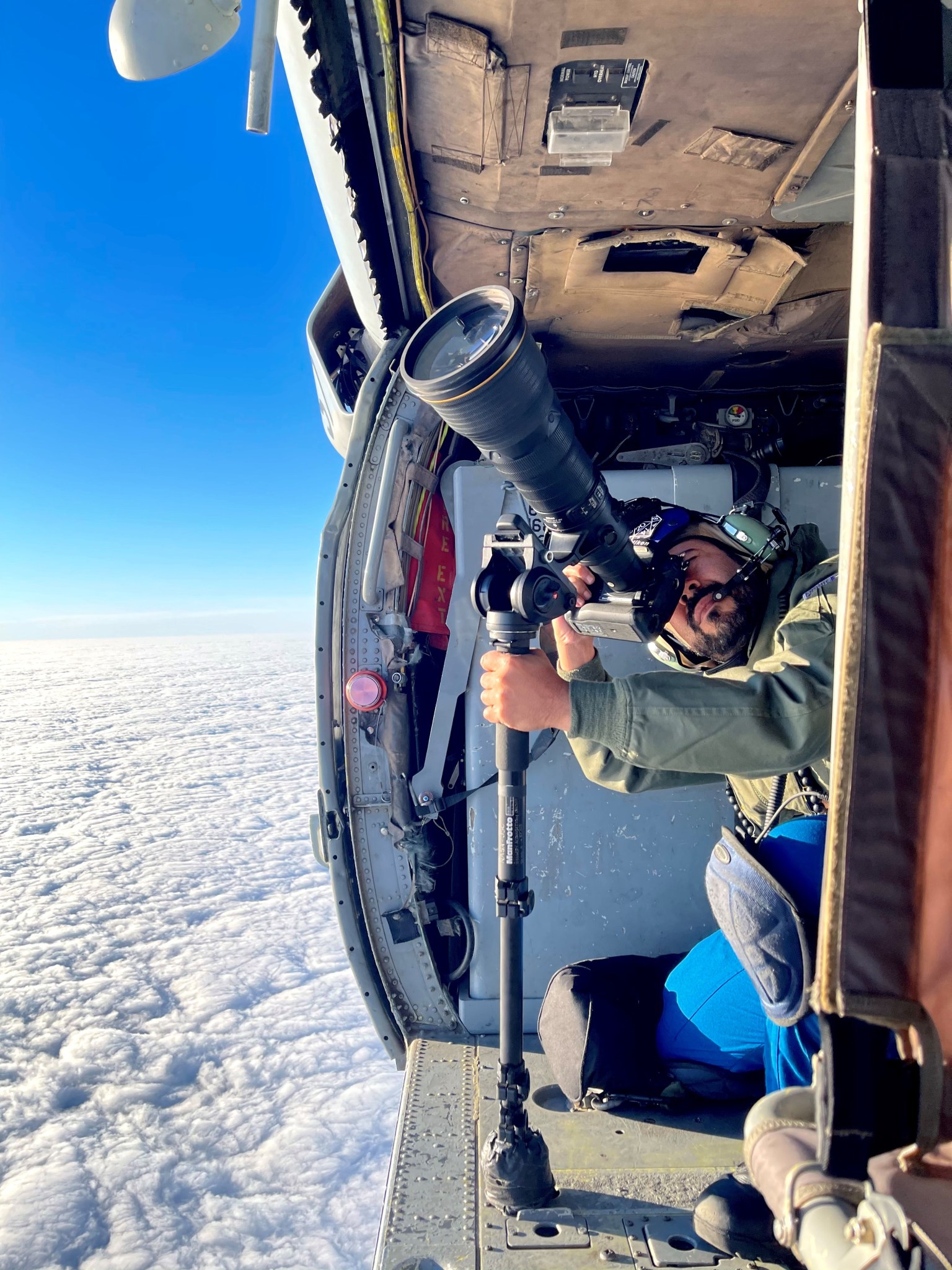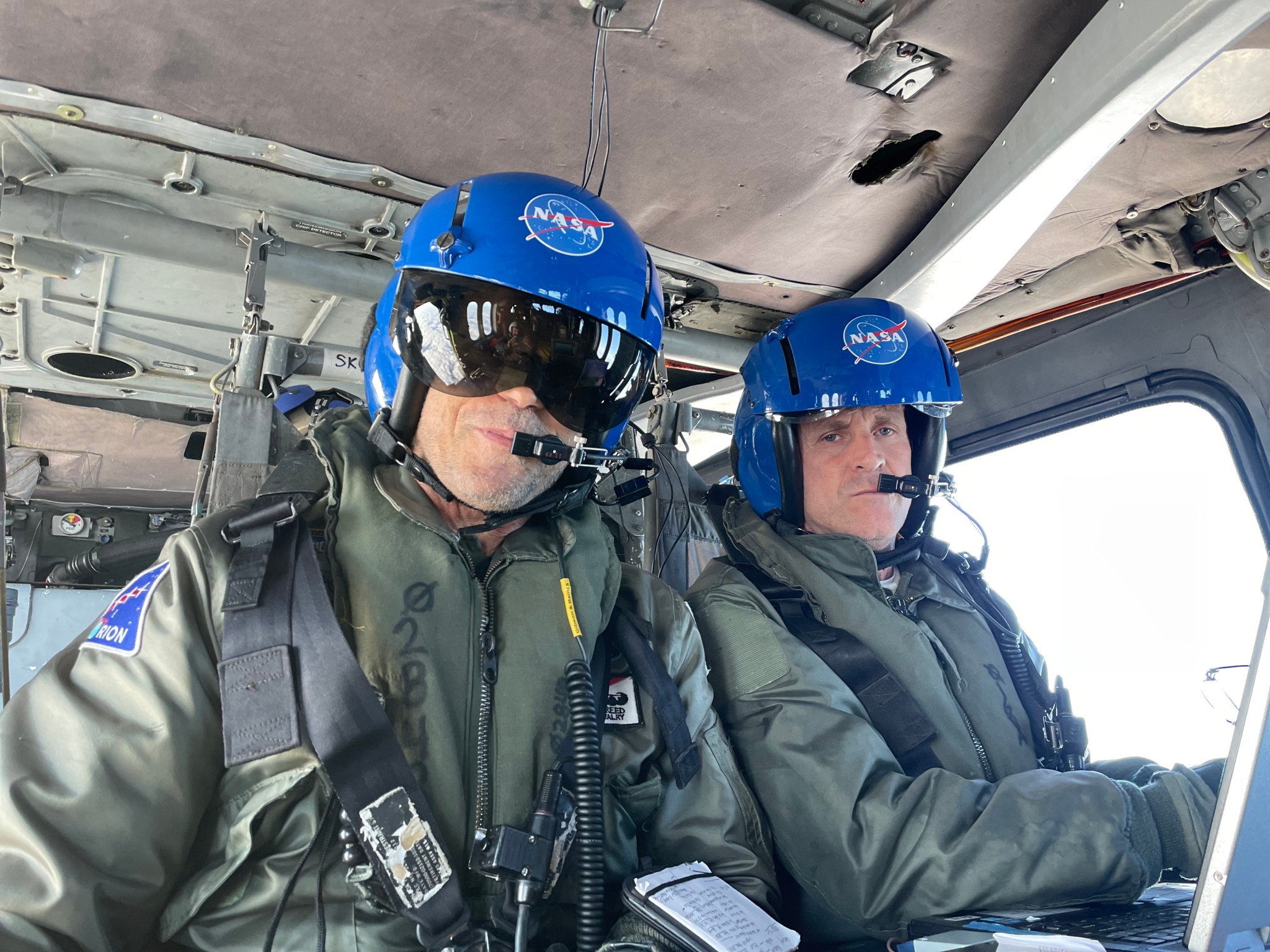When the Orion spacecraft enters Earth’s atmosphere at the end of Artemis missions to the Moon, a joint NASA and U.S. Navy Air Operations team will strategically watch and await its return in two helicopters. The team’s main objective is to capture images of the spacecraft as it returns to Earth from as close as possible — about 10,000 feet in the air — with the helicopter cabin doors wide open.
The air operations personnel are part of NASA’s landing and recovery team, which will retrieve Orion and future crews after they splashdown from lunar missions. During return, Orion will enter Earth’s atmosphere traveling approximately 25,000 mph before air friction slows the spacecraft to about 300 mph. Its parachutes will then deploy and slow the crew module to approximately 20 mph for splashdown in the Pacific Ocean off the coast of southern California.
“Our primary objective is to get quality engineering imagery of Orion during descent and splashdown,” said Don Reed, lead for the NASA Air Operations team. “Parachute analysts can analyze the imagery of components of the crew module recovery system and ensure we are meeting our flight test objectives.”
As Orion returns for splashdown, Reed will be directing his team aboard one of the two naval helicopters in the sky. His helicopter team tracks the crew module, while the other tracks the forward bay cover, the piece of hardware that protects the top portion of the capsule and the parachutes, after it is jettisoned.
Positioned next to Reed will be Jeff Fox, chief engineer of the Rapid Prototyping Lab at NASA’s Johnson Space Center in Houston. The lab develops the crew displays for the Orion spacecraft, and created a debris tool that Fox operates on the helicopter.
The debris tool is a ruggedized laptop with a moving map that tracks debris coming off the spacecraft, such as the forward bay cover, the parachutes, and their associated hardware. Fox will use it to see where potentially hazardous falling debris is so it can be avoided.
“This allows us to get as close as we can to collect the highest-quality imagery possible,” said Fox.

To collect imagery, one team member operates a gyro-stabilized, ultra-high definition 8K video camera system. A still photographer captures images from the back of the helicopter, and a Navy video system mounted on the nose does the same. The imagery the team collects will be recorded and analyzed after the mission, and will not be streamed or shared in real time.
“Finding and tracking the capsule requires a significant team effort,” said Fox. “Nothing about this task is trivial. The difference in getting the imagery, and the precision required to do it, can be measured in a few degrees and seconds.”
On the day of splashdown, the mission control team at Johnson will assist the Air Operations team, letting them know if the spacecraft is deviating from its planned trajectory. The team then sets up its aircraft position to find Orion when it is about 50,000 feet in the sky.
To get the spacecraft in its camera sights, the team uses a Navy system on the aircraft called a multi-spectral targeting system, a turret that uses an infrared video camera. The infrared camera will quickly pick up Orion’s heat shield, which reaches temperatures of nearly 5,000°F during reentry.
“Once the infrared camera operator has Orion in their crosshairs, they’ll announce the position of the spacecraft, allowing the video camera operator to find that point and acquire the crew module,” Reed said. Another crew member, called a spotter, also helps assist the still photographer to find Orion in their field of view.
Once Orion splashes down, the aerial team will communicate with personnel on recovery boats to help them locate the forward bay cover and the main parachutes, which are cut from the crew module and will drift with the ocean currents until recovered.
To prepare, the team runs practice flights, tracking aircraft flying out of San Diego International airport, and practices in the helicopter simulator at Naval Air Station North Island in California. The team recently performed its final mission certification with the Landing and Recovery team ahead of Artemis I during Underway Recovery Test 9 aboard the USS John P. Murtha.
“When we’re all together at sea on the Navy ship, it’s really exciting,” Fox said. “Who wouldn’t be excited when the rotors of the helicopters are turning, you’re on the deck waiting to takeoff, and the spacecraft is hurtling toward Earth at seven miles per second?”
Artemis I is the first in a series of increasingly complex missions, an uncrewed flight test of the Space Launch System rocket and Orion that will pave the way for future crewed missions to the Moon.
Learn more about NASA’s Orion spacecraft at:
Erika Peters
NASA’s Johnson Space Center




























